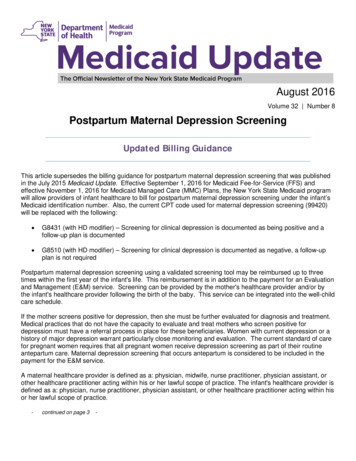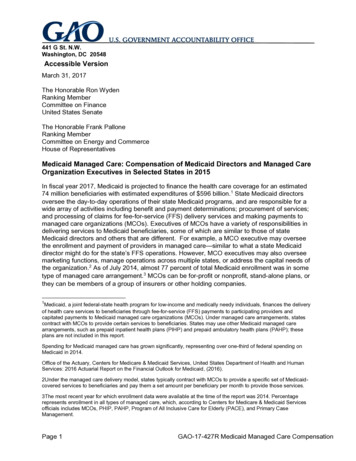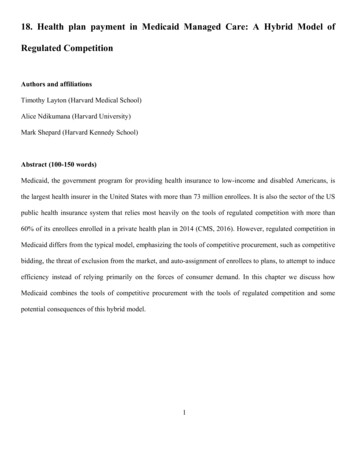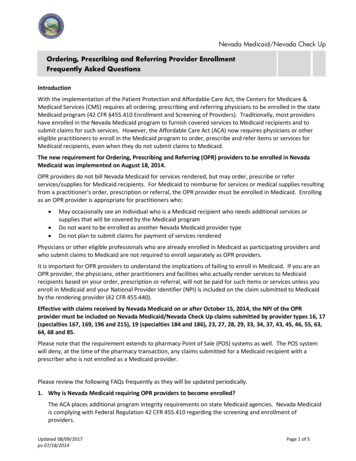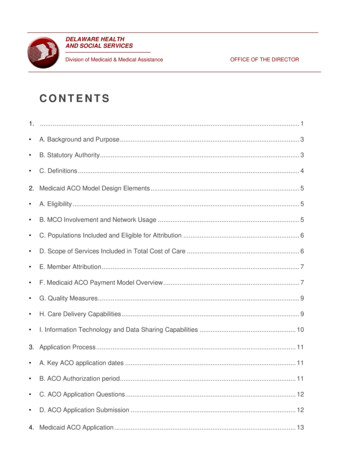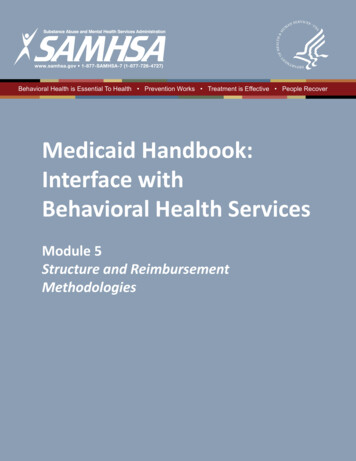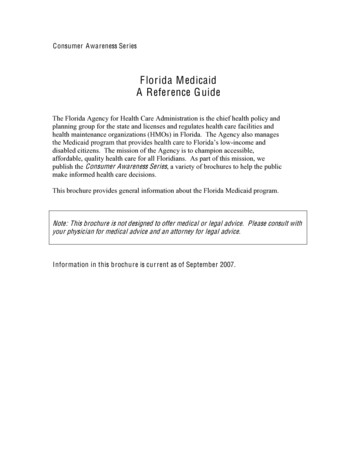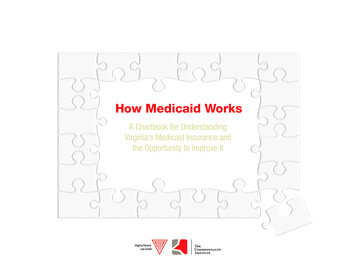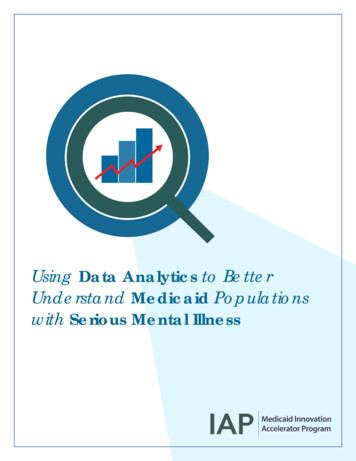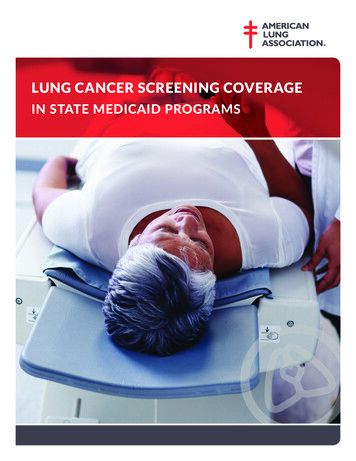
Transcription
LUNG CANCER SCREENING COVERAGEIN STATE MEDICAID PROGRAMS
OverviewLung cancer is the leading cancer killer among both women and men. Early detection is critical to fighting lung cancer,and low-dose computed tomography scans are recommended to screen individuals at high risk and can help catch thedisease when it is most curable.Medicaid beneficiaries are disproportionately affected by lung cancer, yet standard Medicaid programs are one of theonly healthcare payers not required to cover lung cancer screening. To assess the current status of lung cancer screeningcoverage for the Medicaid population, the Lung Association analyzed lung cancer screening coverage policies in stateMedicaid fee-for-service programs.As of January 2019, 31 Medicaid fee-for-service programs cover lung cancer screening, 12 programs do not providecoverage, and 7 states did not have information available on their coverage policy. These Medicaid programs varied inthe eligibility criteria they used for screening as well as whether they required prior authorization. Coverage may alsovary between fee-for-service and managed care plans within a state’s Medicaid program.The number one strategic imperative of the American Lung Association is to defeat lung cancer, and reducing morbidityand mortality associated with this disease is among the Lung Association’s key objectives. The Lung Association urges allstate Medicaid programs to cover lung cancer screening based on evidence-based guidelines across all fee-for-serviceand managed care plans and to remove any financial or administrative barriers that limit access to this lifesaving service.BackgroundLung cancer is the leading cancer killer of both women and men in the United States, accounting for approximately 24percent of cancer deaths.1 Detecting lung cancer in early stages versus late stage is often the difference between life anddeath, but only 16 percent of lung cancer cases are diagnosed early when the disease is most treatable. A primary meansof reducing lung cancer mortality involves screening members of the high-risk population using low-dose computedtomography (LDCT). In August 2011, the National Cancer Institute released results from its National Lung ScreeningTrial and found that screening for individuals at high risk reduces lung cancer mortality by 20 percent compared to chestx-rays.2In December 2013, the U.S. Preventive Services Task Force (USPSTF) released a ‘B’ recommendation for lung cancerscreening for high-risk populations (see box). Approximately eight million individuals in the United States currently meetthe high-risk criteria for screening.3 The Affordable Care Act requires Medicaid expansion plans and most private healthinsurance plans to cover preventive services given an ‘A’ or ‘B’ by USPSTF, meaning that lung cancer screening should becovered without cost-sharing for patients with Medicaid expansion, state health insurance marketplace plans and mostnon-grandfathered private plans. Similarly, Medicare finalized a National Coverage Determination in February 2015,making LDCT scans available to the high-risk population between the ages of 55 and 77.1-800-LUNGUSA Lung.org
For standard Medicaid, coverage of USPSTF recommendedscreenings is not required. If screening is covered, Medicaidprograms may use different eligibility criteria, require priorHIGH RISK POPULATION(Based on USPSTF guidelines)authorization or charge individuals for their scans. Coverage1. 55-80 years of age; andmay also vary between fee-for-service and managed care2. Have a smoking history of at least 30 packplans within a state’s Medicaid program. This is particularlyconcerning as Medicaid enrollees are disproportionately atrisk for lung cancer; 26.3 percent of Medicaid beneficiariesare current smokers, compared to 11.1 percent of individualsyears; and3. Currently smoke or have quit smoking withinthe last 15 years.with private insurance.4 Additionally, the five-year survivalrate for lung cancer patients with Medicaid is significantly lower than for individuals with other insurance (13.0 percent v.20.4 percent).5Recent research shows that screening rates for individuals at high risk for lung cancer are alarmingly low – in 2015, just 4.4percent of individuals who met USPSTF criteria received a chest CT.6 More work is clearly needed to improve both coverageand utilization of lung cancer screening for those at high risk for this disease.FindingsTo assess current coverage of lung cancer screening in state Medicaid fee-for-service programs, the Lung Associationsurveyed state Medicaid programs to obtain information on coverage of LDCT scans for individuals at high risk for lungcancer and reviewed publicly available coverage policies. Coverage information was collected between December 2018and January 2019.As shown in Figure 1, 31 Medicaid fee-for-service programs cover lung cancer screening, 12 programs do not providecoverage, and 7 states did not have information available on their coverage policy. Tennessee is the only state that doesnot cover any enrollees through a fee-for-service program and therefore was excluded from this analysis.1-800-LUNGUSA Lung.org
Figure 1: Coverage of Lung Cancer Screening in State Medicaid Fee-for-Service ProgramsCoveredNot CoveredNot AvailableNo FFS Program*Notes:1. Data collected December 2018 – January 2019.2. States that only cover Medicare crossover claims (claims for dual eligibles where Medicaid pays remaining cost-sharing notcovered by Medicare) are included in the “not covered” category.3. Data is not available for Tennessee because all Medicaid enrollees are covered through managed care plans.Establishing clear eligibility criteria for lung cancer screening is important to ensure that only those who are at high riskfor lung cancer obtain screenings. Recent research has shown that screening is often inconsistent with evidence-basedguidelines, with the number of individuals inappropriately screened for lung cancer actually exceeding the numberscreened according to USPSTF criteria in 2015.7 Screening people who do not meet the high risk criteria puts peopleat risk for false positives and unnecessary invasive procedures. Among states that cover lung cancer screening in theirMedicaid fee-for-service program, eligibility criteria for screening varies. As shown in Table 1, 13 states follow theUSPSTF criteria, three states follow the Medicare criteria and 15 states have other criteria.Finally, some states may require providers to obtain prior authorization from the Medicaid program before screeningwill be covered. Prior authorization requirements can delay patients’ access to care and even lead some patients toabandon treatment.8 As shown in Table 1, among states that cover lung cancer screening in their Medicaid fee-forservice program, 13 states require prior authorization for this service.1-800-LUNGUSA Lung.org
Table 1Eligibility Criteria and Prior Authorization Requirements for State Medicaid Fee-For-Service ProgramsCovering Lung Cancer ScreeningStateEligibility CriteriaPrior tanaOtherNoNevadaUSPSTFNoNew HampshireUSPSTFNoNew YorkUSPSTFYesNorth gonUSPSTFNoPennsylvaniaOtherYesSouth CarolinaUSPSTFNoSouth gtonUSPSTFYesWest VirginiaOtherYesWisconsinUSPSTFYesNote: Eligibility Criteria – USPSTF recommends screening for individuals ages 55 to 80 years who have a smoking history of 30pack years and currently smoke or have quit smoking within the last 15 years; Medicare covers screening of individuals ages55 to 77 years who have a smoking history of 30 pack years and currently smoke or have quit smoking within the last 15 years;“Other” includes programs that have criteria that is similar but slightly different from USPSTF or Medicare, as well as programsthat have no formal eligibility criteria for screening.1-800-LUNGUSA Lung.org
ConclusionThis analysis reveals that gaps remain in access to lung cancer screening for the Medicaid population. It is important tonote that this analysis only looked at lung cancer screening coverage in Medicaid fee-for-service programs, not acrossall Medicaid managed care plans in states. While many managed care organizations follow fee-for-service coverage,they may differ in their eligibility criteria, prior authorization requirements, and other features of their coverage policies.Similarly, in states that do not cover lung cancer screening in their fee-for-service programs, managed care plans maystill cover this service. Additionally, even when screening is covered, much more work is needed to educate patients andproviders and remove barriers to screening that could improve the alarmingly low utilization of this service among thoseat high risk for lung cancer. To educate the public about lung cancer screening, the American Lung Association’s LUNGFORCE launched Saved by the Scan in 2017 in partnership with the Ad Council.The Lung Association urges all state Medicaid programs to cover lung cancer screening based on evidence-basedguidelines across all fee-for-service and managed care plans and to remove any financial or administrative barriers thatlimit access to this lifesaving service.The American Lung Association would like to thank The University of Texas MD Anderson Cancer Center for the support forthis analysis.1Siegel RL, Miller KD, Jemal A. Cancer Statistics, 2019. CA: A Cancer Journal for Clinicians. 2019; 69: 7-34.2The National Lung Cancer Screening Trial Team. Reduced Lung-Cancer Mortality with Low-Dose ComputedTomographic Screening. New England Journal of Medicine, August 2011; 365(5): 395-409.3Richards TB, Doris-Rose VP, Soman A, Klabunde CN, Caraballo RS, Gray SC, Houston KA, White MC. Lung Cancer Screening Inconsistent With U.S. Preventive Services Task ForceRecommendations. American Journal of Preventive Medicine, Jan 2019; 56(1): 66-73.4Centers for Disease Control and Prevention. National Center for Health Statistics. National Health Interview Survey, 2017. Analysis performed by the American Lung AssociationEpidemiology and Statistics Unit using SPSS software.5U.S. National Institutes of Health. National Cancer Institute: SEER 18 Registries database, November 2015 submission, SEER*Stat version 8.3.2.6Richards TB, Doris-Rose VP, Soman A, Klabunde CN, Caraballo RS, Gray SC, Houston KA, White MC. Lung Cancer Screening Inconsistent With U.S. Preventive Services Task ForceRecommendations. American Journal of Preventive Medicine, Jan 2019; 56(1): 66-73.7Richards TB, Doris-Rose VP, Soman A, Klabunde CN, Caraballo RS, Gray SC, Houston KA, White MC. Lung Cancer Screening Inconsistent With U.S. Preventive Services Task ForceRecommendations. American Journal of Preventive Medicine, Jan 2019; 56(1): 66-73.8American Medical Association, 2017 Prior Authorization Physician Survey, Feb. 2018. Accessed at: USA Lung.org
West Virginia Other Yes Wisconsin USPSTF Yes 1-800-LUNGUSA Lung.org Table 1 Eligibility Criteria and Prior Authorization Requirements for State Medicaid Fee-For-Service Programs Covering Lung Cancer Screening Note: Eligibility Criteria - USPSTF recommends screening for individuals ages 55 to 80 years who have a smoking history of 30


